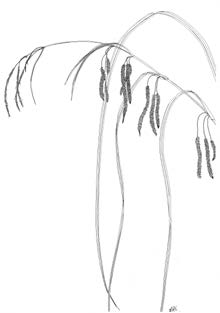Trip Report – 2 November 2013: “Muri Bush”, Pukerua Bay
 |
Carex geminata. Illustration: Eleanor burton.
|
We assembled on the deck in front of Ted Coats’ and Cath Pearson’s home, where they welcomed us to their property, with its magnificent outlook towards Kapiti Island. They described how in 2008 they had purchased the 4-ha site, with mature coastal forest, regenerating forest, shrubland,
Carex geminata sedgeland and flaxland, and were working to control pest animals, pest plants and other weeds, helped by Greater Wellington Regional Council. Ted said that they would welcome our comments on the management of the property, and that we would be given a list of questions to stimulate discussion.
After he had described the track network, we set off in groups, armed with a list of native and adventive plants prepared by Pat Enright. Among the sights were
Streblus banksii / large-leaved milk tree, an extensive area of big, multi-trunked kanuka, with wind-shorn canopy, kiekie, massive, multi-trunked ngaio, an 18-m tall lancewood, and several orchids in flower. Ted has poisoned several large karaka, and they spend time pulling out seedlings of this invasive species, which is believed to be naturally occurring only in northern parts of the North Island.
In answering questions put to us, we said that we were impressed with Handford and Associates’ report on the restoration plan for the property, in particular the focus on the most destructive pest plants and animals. We supported the removal of karaka and karo, and recommended that pseudopanax hybrids, pohutukawa and
Hoheria populnea be removed. Given that this is the best-preserved area of coastal forest in the vicinity, we could not say what species may be missing, and could reasonably be expected to be present We applauded the intensity of pest-animal and pest-plant control efforts, these being essential to protect all native plant species present, not just any rare plants there. We believe that the way this ecosystem is being managed is a classic example of the way to manage native ecosystems. We recommended that puriri not be planted here, because of its known weediness in forests south of its natural range, and said that continued intensive pest-animal and plant control is the ecologically sound approach to making the forest attractive to birds, lizards, invertebrates, and to plant species not at the moment here. We believe that Victoria University’s School of Biological Sciences, also Landcare Research, could be interested in baseline monitoring, and other research, on the property.
After lunch on the deck, we again set off in groups, to botanise areas we had not visited in the morning. Among the additions to the list during the day were tarata, scarlet rata, the ferns
Hypolepis dicksonioides and
Pteris macilenta, the sedge
Gahnia pauciflora, and the weedy
Hoheria populnea, and
Pseudopanax crassifolius x
P. lessonii hybrids. We added several adventive weed species, including
Syzygium paniculatum / scrub cherry, the maidenhair
Adiantum raddianum,
Nephrolepis cordifolia, and fathen
Chenopodium album.
Participants : David Allen, Ros Batcheler, Rhonda Billington, Ted Coats (co-scribe), Rae Collins, Gavin Dench, Ian & Jill Goodwin, Martin Heine (co-leader), Chris Horne (co-leader / co-scribe); Sheena Hudson, Priscilla Isaacs; Rodney Lewington, Barbara Mitcalfe, Syd Moore, Cath Pearson (co-scribe), Leon Perrie, Hugh & Lea Robertson, Jeremy Rolfe, Nick Saville, Darea Sherratt, Sunita Singh, Margaret Thompson, Geoff & Helen Willberg.

 Site Index
Site Index







 Site Index
Site Index





